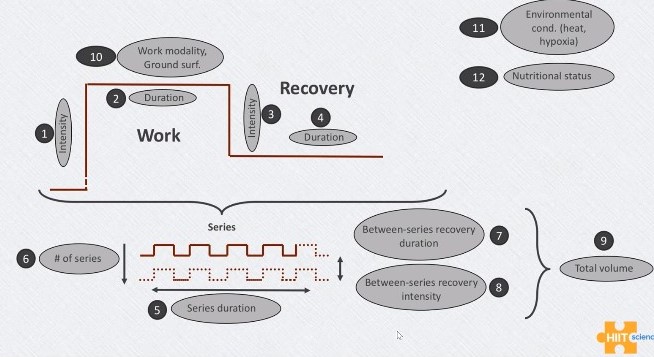Fartlek, repeated-sprint efforts, HIIT, tabata… They’re all forms of interval training – a popular and highly effective form of training prescription. Interval training has become really trendy within the fitness industry in recent years; in fact, according to the Worldwide Survey of Fitness Trends1 high intensity interval training (HIIT) has been in the top 5 every year since 2014, and was the #1 fitness trend in 2018 & #3 last year.
What is Interval Training?
Repeated short to moderate length bouts of relatively intense exercise, typically involving activities that recruit large muscle mass (e.g. cycling, running, rowing) interspersed with short periods of recovery (either active or passive)2,3
Key parameters are manipulated to design interval training sessions targeting desired physiological outcomes. These are outlined in the image below and include:
- Intensity & duration of work bouts
- Intensity & duration of recovery between work bouts
- Duration of the series, number of series and duration of recovery between
- Total volume of the session
- Type of exercise, environmental conditions, nutritional status

By using specific work-to-rest ratios we can elicit improvements in specific components of fitness. In general:
- Exercise to rest (1:1) = short/long-term aerobic energy system
- Exercise to rest (1:2) = short-term glycolytic energy system
- Exercise to rest (1:3) = immediate PCr-ATP energy system
Why use Interval Training?
Interval training is an effective way to improve health outcomes including cardiovascular health, respiratory function, and weight loss. Extraordinary amounts of high-intensity work can be performed in a shorter duration than continuous endurance training to achieve the same volume of work. They offer a real bang for your buck!
HIIT produces greater increases in aerobic fitness than moderate intensity continuous training (MICT) for a given training volume, and sprint interval training (SIT) is able to improve fitness to the same extent as endurance exercise but for a lower volume of training3! As an example, a 6 week study comparing SIT (4-6 x 30s hard & 270s recovery) vs. endurance training (40-60mins at 65% effort) showed both training programs produced the same improvements in aerobic fitness, but the sprint group achieved this with only one-third the weekly time commitment as the endurance group4.
A recent meta-analysis comparing HIIT to MICT also showed greater reductions in total absolute fat mass with the interval training5. In one study, a group of women performing the Trapp method 3x/week for 15 weeks experienced similar increases in aerobic fitness to those who performed a steady-state endurance training program (60% intensity for up to 40mins). But notably the interval training group also reduced total body mass and fat mass, especially around the trunk and legs6.

It’s also a more enjoyable way to train. A recent study showed that, compared to continuous training, HIIT rated higher levels of enjoyment and was the preferred type of session by 92% of participants despite being more physically demanding7. The intermittent nature of HIIT provides a constantly changing stimulus that breaks sessions up into smaller blocks of work interspersed with recovery, and since higher intensities can be achieved this may provide a sense of accomplishment. Adherence to an exercise program is largely affected by perceived enjoyment and time availability, so it makes sense that by incorporating a time-efficient and enjoyable stimulus into your training, you’ll be more likely to stick with it long term.
Examples of different interval training sessions
Sprint Interval Training
Sprint training is a form of interval training, but not all intervals are sprints. The key here is the intensity of the work which drives favourable outcomes for body composition. Because of the extreme effort, the duration of the interval is short and there is substantial rest to fully recover between efforts in order to be able to repeat the “all out” effort. For example:
- 30s maximum effort sprint
- 2-4mins rest (either fully rest or low-intensity activity)
- Repeat 6 times
Tabata
A form of HIIT discovered by Japanese scientist Izumi Tabata which produces significant aerobic and anaerobic improvements. Each exercise in a Tabata workout lasts only 4mins and is structured as 20s hard:10s rest, repeated 8 times. An example of a Tabata session might look like:
- 8 x 20/10 Burpees
- 8 x 20/10 KB Swings
- 8 x 20/10 Med Ball Slams
- 8 x 20/10 Jump Squats
Trapp
Short intense intervals involving 8s high intensity effort with 12 seconds active recovery. The two components to this are that the 8s effort must be performed at an extremely high cadence, and the recovery involves some form of lower intensity exercise. For example:
- 8s maximum sprint on bike
- 12s slow, rolling legs over
- Repeated 60x (20mins total)
************
